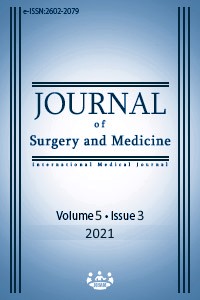Evaluation of the effects of ultrasound-guided infraclavicular nerve block on postoperative pain in pediatric supracondylar fracture surgery
Keywords:
Supracondylar surgery, Infraclavicular nerve block, General anesthesia, Ultrasonography, Visual analogue scoreAbstract
Background/Aim: Ultrasound-guided upper and lower extremity nerve blocks offer significant advantages in adult patients. However, the effectiveness of these advantages in children is being investigated. The aim of this study was to evaluate postoperative pain scores of single-injection infraclavicular nerve block in pediatric patients who underwent supracondylar surgery. Methods: Forty-one patients who underwent supracondylar surgery between December 2016 and December 2017, with either general anesthesia (GA, n=19) or ultrasound-guided infraclavicular block (ICB, n=22) were included in this retrospective cohort study. Postoperative visual analogue scale (VAS) pain scores at the 30th min, 2nd, 6th, 12th, and 24th hours, the total amount of pethidine and paracetamol administered, and time until the first analgesia requirement were evaluated. Results: The demographic characteristics of the patients were similar (p>0.05). The VAS scores and total amount of consumed pethidine and paracetamol were lower in the ICB group in the first 12 hours than in the GA group, but the opposite was true at the 24th hour (P<0.001). The first analgesia requirement time was much longer in the ICB group than in the GA group (P<0.001). The two groups were similar in terms of complications (P<0.05). Conclusion: Ultrasound-guided infraclavicular block could be a useful option for postoperative analgesia control in patients undergoing supracondylar surgery.
Downloads
References
Carson S, Woolridge DP, Colletti J, Kilgore K. Pediatric upper extremity injuries. Pediatr Clin North Am. 2006;53:41–67.
Bilal B, Boran OF, Sargon MF, Başaran KE, Doğaner A. Electron microscopic examination of needles used in infraclavicular brachial plexus block. J Surg Med. 2020;4(1):5-8.
Fisher P, Wilson Se, Brown M, Ditunno T. Continuous infraclavicular brachial plexus block in a child. Pediatric Anesthesia. 2006;16:884–6.
Bricker SR, McLuckie A. Nightingale DA. Gastric aspirates after trauma in children. Anaesthesia. 1989;44:721–4.
Kretz FJ, Krier C. A child with a full stomach has to be anaesthetized. Anästhesiologie Intensivmedizin Notfallmedizin Schmerztherapie. 2002;37:514–9.
Klaastad Ø, Smith HJ, Smedby O, Winther-Larssen EH, Brodal P, Breivik H, et al. A novel infraclavicular brachial plexus block: the lateral and sagittal technique, developed by magnetic resonance imaging studies. Anesth Analg. 2004;98(1):252-6.
Fleischmann E, Marhofer P, Greher M, et al. Brachial plexus anaesthesia in children: lateral infraclavicular vs axillary approach. Paediatr Anaesth. 2003;13:103–8.
Hadzic A, Arliss J, Kerimoglu B. A comparison of infraclavicular nevre block versus general anesthesia for hand and wrist day case surgeries. Anesthesiology. 2004;101:127-32.
Aboobacker S, Balakrishnan A, Mahmood SF, Padmanabha S. Effıcacy of contınuous ınfraclavıcular brachıal plexus block ın postoperatıve paın control after upper extremıty orthopaedıc surgery. Journal of Evolution of Medical and Dental Sciences. 2015;99(4):16464-9.
Tobias, JD. Brachial plexus anaesthesia in children (Review). Paediatric Anaesthesia. 2001;11(3):265-75.
Hanison J, Ashworth A. Regional anaesthesia: awake or asleep? Br J Hosp Med (Lond). 2011;72:178.
Marhofer P, Frickey N. Ultrasonographic guidance in pediatric regional anesthesia part 1: theoretical background. Pediatric Anesthesia. 2006;16:1008–18.
De José BM, Banús E, Navarro Egea M, Serrano S, Perelló M, Mabrok M. Ultrasound‐guided supraclavicular vs infraclavicular brachial plexus blocks in children. Pediatric Anesthesia. 2008;18:838–44.
Downloads
- 428 610
Published
Issue
Section
How to Cite
License
Copyright (c) 2021 Faruk Çiçekci, Mehmet Sargın, İnci Kara
This work is licensed under a Creative Commons Attribution-NonCommercial-NoDerivatives 4.0 International License.
















